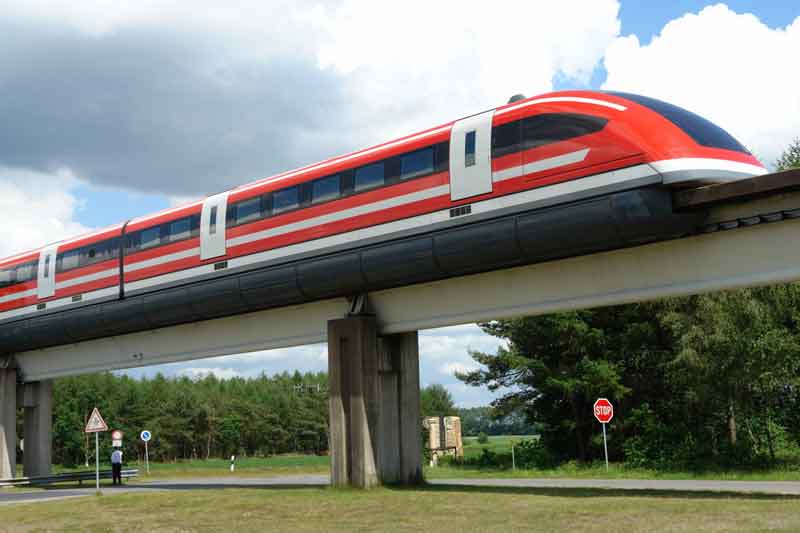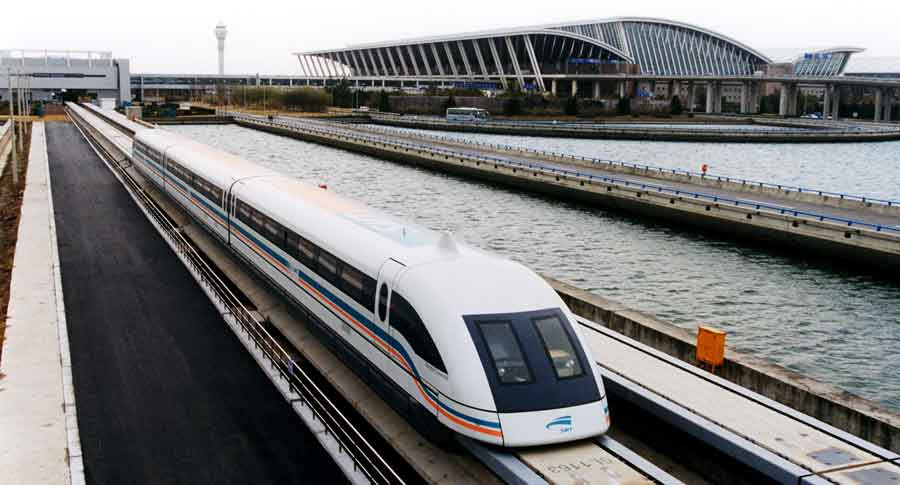Shanghai to Brooklyn in 2 hours
“Are we there yet?”
Even people who love road trips will occasionally get bored during a long drive. Cutting down travel time helps to make traveling to different parts of the world easier and more accessible. There is a lot of interest in exploring technologies that can make travel fast and safe. A vehicle known as a maglev train is one type of transportation technology that seems to hold a great deal of promise in that respect.
 A test German facility for the Transrapid train. Public Domain image
A test German facility for the Transrapid train. Public Domain image
The word “maglev” comes from magnetic levitation. Maglev trains use magnets to exert a force and levitate the train so that it doesn’t come into contact with the ground. Because the train is not in contact with the ground, friction is minimized as the train travels through the air. The magnets also exert a force and create propulsion to push the train forward. Because the trains make little contact with the ground, weather is not as likely to interfere with travel as it would be for other forms of transportation.
 The same magnetic forces that hold up your refrigerator art can propel high speed trains. Image from Thinkstock
The same magnetic forces that hold up your refrigerator art can propel high speed trains. Image from Thinkstock
How much faster would it be to travel on a maglev train than a traditional train? Consider the fact that it currently takes 74 hours (a little over three full days) to go from New York to California on a train. On a maglev train, you could make that trip in 16 hours, well under a full day!
At the time of this writing, there are only two commercial maglev trains in operation. There is the Transrapid system in Shanghai, China (the most populous city in China) and the Linimo line in Japan. There are two other trains being planned: One in Seoul, South Korea and the other in Beijing, China’s political and cultural capital as well as one of the most populous cities in the world.
 This train is heading out of Pudong International Airport in Shanghai. Public Domain image
This train is heading out of Pudong International Airport in Shanghai. Public Domain image
Despite the attractive proposition to reduce travel times, maglev trains are not widely used. Construction of maglev trains can be controversial. The construction costs for maglev trains are incredibly high, so people wonder if they are worth the expense. On the other hand, the trains and tracks don’t experience as much wear and tear as traditional trains. Over the long run, it may be much cheaper to maintain maglev trains than traditional trains.
 How would you like to go from New York to China in 2 hours? Image from Thinkstock
How would you like to go from New York to China in 2 hours? Image from Thinkstock
What does the future hold for maglev trains? It is hard to say. Technologies known as vacuum tube trains (or vactrains) send maglev trains through a vacuum tube. These trains travel through airless tunnels, further reducing friction and allow the trains to move even faster. They would require very little power to run, making them very efficient. A vactrain could go from New York to Beijing in 2 hours, thus becoming the world’s fastest mode of transportation. These trains could move 8,000 km per hour. That is faster than the speed of sound! In order to make vactrains a reality, we would need to make advances in the technology for the tunnels.
Maglev trains are a fascinating technology. As a society, we are still figuring out how much we value the investment into this type of technology. Even faster transportation is just on the horizon with vactrains.
What changes would we expect to se in a society where you can go around the globe in just under two hours? What does that mean for the future of work, vacations and family life?
